From our kitchens to yours: Recipes from around the world
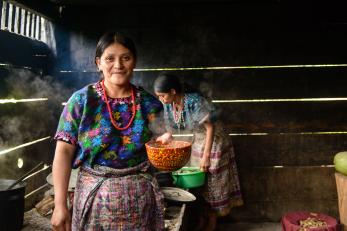
Celebrating the harvest season is a tradition held among cultures and communities around the globe. It’s around meals like these that we come together to celebrate, communicate, and connect.
And even though the COVID‑19 pandemic has changed how we physically gather and socialize, it has created a new universal experience — of struggle and perseverance — in which food remains a common thread.
Through meals, Emma Mendez Rossell, a Mercy Corps team member from Guatemala, has felt the same waves of steadiness and sorrow many of us can relate to during this crisis — and that more yet face chronically and daily.
Running low on food during the shelter-at-home order in her community, she fretted how to provide for her family, knowing the local supermarket wasn’t keeping up with demand.
“It was the first time in my life I began to worry about not having food to feed my family,” she says. “I then realized how lucky I am … I could only imagine the pain of a parent not being able to provide for their families in this or other times.”
Alternately, for Emma, the time at home has allowed her an opportunity to connect with her family and find gratitude through games, reading, calls with friends, and — not least of all — through food.
“With my family, everything is about planning and keeping a schedule,” she says. “We made sure each of us had a schedule that allowed us to work and study … and to cook lunch together as a family project.”
Connecting over food is essential in her Guatemalan heritage. “It’s around food that families celebrate and grieve,” she says.
And she isn’t alone. With local staff in more than 40+ countries, the Mercy Corps team is just as diverse as the communities it serves. But, right now, we are all part of one shared experience, many of us, like Emma, turning to food to provide comfort, perspective, and creativity as we cope with the upheaval of a global pandemic.
Below, hear what some of them say about culinary customs and the impact of this crisis in their home countries. And if you’re interested in using your time at home to try new recipes in your kitchen, use the instructions below to cook up our team’s favorite traditional meals.
- Guatemala: Kaq ik
- Jordan: Lentil soup
- Democratic Republic of Congo: Beans and fufu
- Nepal: Dal, bhat and tarkari
- Uganda: Sweet potatoes with malakwang sauce
- Timor-Leste: Marotok
Guatemala: Kaq ik
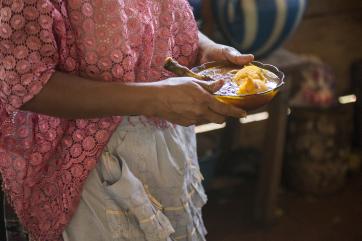
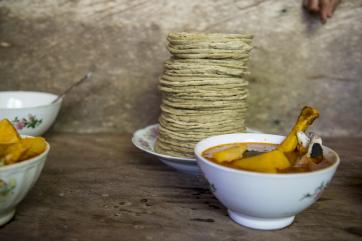
In Guatemala, food is one of the primary and most heartfelt ways families and communities connect with one another. “Food in Guatemala represents an opportunity to meet and to share with others,” Emma says. “Culture is shared through meals.”
While this has drastically changed with movement restrictions, closed businesses and decreased incomes, traditionally guests are greeted with a dish of kaq ik, a soup made from turkey, grilled tomatoes and spices which is often served on special occasions like weddings, births and other celebrations.
“When someone offers you food in Guatemala, they are offering a piece of their culture. They are sharing what they don’t have,” says Emma. “Many of the families we [Mercy Corps] visits have very limited resources. However, within their limitations, they always have something to share.”
Guests are commonly given a portion of food to take home to share with their own families, and it’s considered rude not to receive the offering.
“Food allows us to connect to our traditions and our community,” Emma says. And a greater connection is something that can have a meaningful impact, especially right now. “If it’s possible for you, try to share a meal with a neighbor. It means a lot that others around you care for you.”
To prepare kaq ik at home, here is Emma’s recipe:
Ingredients
- 6 medium tomatoes, diced
- 1 large onion, diced and separated into two portions
- 2 red bell peppers, diced
- 1 dried guaque chili, diced
- 1 dried pasa chili, diced
- 6 dried Cobán chilis, diced
- Turkey stock (optional)
- 2-3 turkey legs
- Abundant garlic cloves, peeled and separated
- 1 tablespoon achiote paste
- Chopped zamat (cilantro)
- Extra chopped cilantro leaves, to garnish
- Salt to taste
Steps
- Combine tomatoes, half the onion, red bell peppers, garlic, guaque chili, pasa chili and coban chilis in a pot and cook until soft. It is recommended to brown the skins, but make sure they do not completely burn.
- Move the chili mixture to a blender and puree. Add ½ cup turkey stock, to thin, if desired. Set sauce aside.
- Combine turkey legs, remaining onion and garlic cloves in a large pot and cook until turkey is thoroughly cooked through.
- Add the red sauce to the turkey and stir well.
- Add abundant zamat (or regular cilantro) and bring to a boil. Reduce heat to medium low and cook for 30 more minutes.
- Salt to taste. Serve in bowls, garnished with cilantro, paired with white tamales and white rice if desired.
Download printable recipe cards for this dish and more ▸
Jordan: Lentil soup
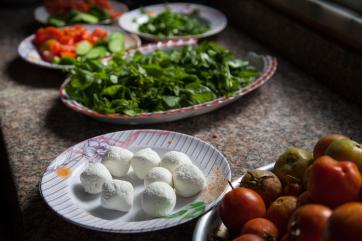
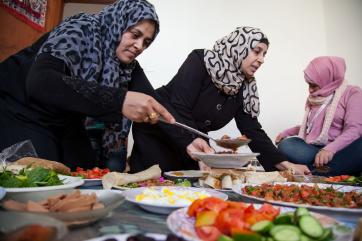
Eating is customarily a social affair in Jordan — meals are often intimate, with the group eating from the same platters and foregoing utensils in favor of fingers or fresh bread.
And while many people aren’t joining together for meals as they traditionally would, they are still leaning on cooking just as much as ever to feel connected.
Since sheltering in place became essential, “we started looking more into home cooking,” says Lamia Dabbas, a team leader in Jordan. “[It’s been a way to] have more quality time with the family.”
And a staple in the Jordanian diet is classic lentil soup. “In Jordan, you know it’s winter when you smell this soup!” Lamia explains. But the comfort of warm soup extends across seasons and, with Lamia’s unique recipe, it can be shared with your loved ones even if you’re unable to enjoy it together.
Play the video below to learn how to give Jordanian lentil soup as a gift, paired with printable instructions.
“Cooking has become a daily activity with family members, as entertainment,” she says.
Here, she has provided her lentil soup recipe to enjoy with your own family:
Ingredients
- 6 cups water
- 2 tablespoons chicken or vegetable bouillon
- 2 ½ cups dried lentils
- 4 tablespoons dried minced onion
- ½ cup carrots, finely chopped
- 2 tablespoons olive oil
- 2 tablespoons butter
- Lemon juice, salt and pepper to taste
Steps
- Combine water, bouillon, lentils, onion, carrots, olive oil and butter in a large pot. Cook for 30 minutes.
- Puree or mash mixture until smooth.
- Add lemon juice, salt, and pepper to taste.
- Serve warm.
Download printable recipe cards for this dish and more ▸
Democratic Republic of Congo: Beans and fufu
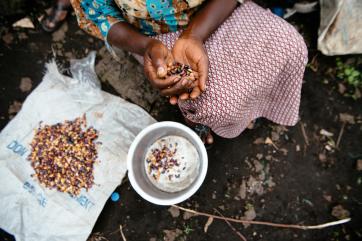
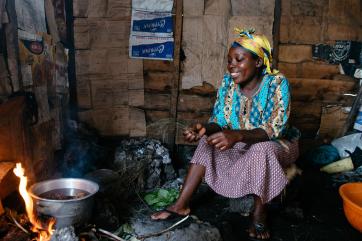
According to Baby Muzi, a native of DRC, traditional Congolese cuisine has few frills. It’s simple food with little spice — think beans and other legumes, sweet potatoes, rice, and fufu (pronounced foo-foo), a plain, sticky dough that takes the place of utensils in most meals. Still, Baby says, Congolese people love to eat.
Beans, in particular, are common throughout the country because they’re affordable and can be stored for long periods of time without perishing — traits especially important now as the pandemic has made food more expensive and less available in many places. And one of the country’s most traditional meals is basic beans and fufu.
Traditionally, beans are cooked in oil instead of water, and sometimes things like onions, bell peppers or tomatoes and spices like garlic, coriander and white pepper are added to taste. And fufu? That’s made by pounding maize or cassava root into a fine flour, then adding the flour to boiling water and stirring until it becomes a thick, smooth, tacky dough. Fufu is traditionally eaten in bite-sized pieces with the right hand — it serves as a scoop to collect the sauce, beans or meat that make up the rest of the meal.
And if you’re doing as the Congolese do, you’re cooking over an open fire. “A kitchen? I wish,” says Baby. “In Congo the majority of kitchens are not modern.” Most families cook using firewood or charcoal, she explains, and they wash their dishes in a big basin on the ground.
To make fufu in your modern kitchen, try this recipe.
Ingredients
- ¾ cup cassava flour
- ¾ cup semolina flour (or corn flour)
- 1 cup cold water
- 3 cups boiling water
- ½ teaspoon salt
- oil, for greasing
Steps
- Combine the cassava flour and semolina flour with the cup of cold water. Stir until lumps of flour are gone.
- Bring three cups of water to the boil with the salt.
- Pour the wet flour mixture into the boiling water and stir continuously. Once it has a thicker consistency, cover and boil on low heat for five minutes. Continue stirring, adding additional flour as needed, until you have a thick dough.
- Using a small greased bowl, scoop a fourth of the fufu dough into the bowl and form into a smooth ball. Tip the ball onto a serving plate. Repeat this process to use all the fufu.
- Serve the fufu warm or at room temperature.
Download recipe cards for this dish and more ▸
Nepal: Dal, bhat and tarkari
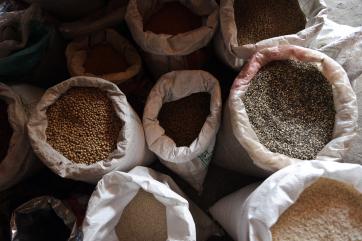
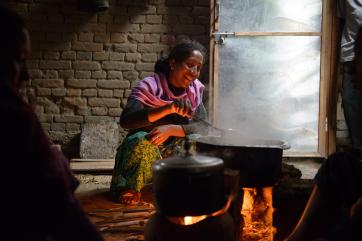
“In Nepal, guests are treated as gods. It is [our] culture to welcome them with homemade traditional food,” says Aishwarya Rana, a former deputy manager in Nepal. “And usually all major festivals include families coming together and eating traditional food.”
Though people aren’t gathering as they normally do, the most common traditional Nepali meal remains the typical dal, bhat and tarkari. It also happens to be Aishwarya’s favorite.
“I like it because it is healthy and tasty,” she tells us. Dal is a soup made of lentils and spices and usually served with bhat (steamed rice) and tarkari (vegetable curry).
Nepali cuisine as a whole is quite diverse, just like the country’s geography and culture. But, Aishwarya explains, you’ll generally find plenty of colorful spices like turmeric, cardamom, ginger and garlic. Other traditional foods nationwide include gundruk (sun-dried, fermented vegetable leaves) and sel roti (rice doughnuts), which are served throughout the country during festivals.
“In Nepal, culinary traditions are passed down from generations,” Aishwarya tells us. “In some families it is [our] custom for men to eat before the women. Other families begin their meal by providing a small amount of food to their gods and ancestors.”
If you enjoy exploring recipes from around the world, this recipe for a potato, bean, bamboo shoot tarkari can bring Nepal’s traditions to you:
Ingredients
- 3-4 medium potatoes, peeled and chopped
- 1 cup fermented bamboo shoots (or canned bamboo shoots)
- 1 cup black-eyed beans (black-eyed peas)
- 2 medium tomatoes, chopped
- 2-3 fresh green/red chilies, halved
- 1 ½ tablespoons cumin and coriander powder mix
- 1 teaspoon red chilli powder
- ½ teaspoon turmeric powder
- 1 tablespoon ginger paste
- 1 tablespoon garlic paste
- 1 medium onion, chopped
- 2-3 tablespoon vegetable oil
- ½ teaspoon cumin seeds
- ½ teaspoon fenugreek seeds
- Salt
Steps
- Soak the beans overnight. Boil the soaked beans and potatoes until cooked.
- Heat 2-3 tablespoons of vegetable oil in a cooking pot, and fry the cumin and fenugreek seeds. Add the chopped onion, ginger paste, and garlic paste, and cook until light brown. Then add the halved fresh chilies and a ½ teaspoon of turmeric powder.
- Add a cup of fermented bamboo shoots and fry for a minute. Add chopped tomatoes and cook until they become soft. Add 1 ½ tablespoons of cumin and coriander powder mix and a teaspoon of red chili powder.
- Add the chopped boiled potato (skin removed) and beans. Add salt to taste, and stir occasionally for 4-5 minutes.
- Pour in 3-4 cups of water, and cook for around 15 minutes over medium-low heat. The tangy, hot and spicy soup is ready to be served.
Download printable recipe cards for this dish and more ▸
Uganda: Sweet potatoes with malakwang sauce
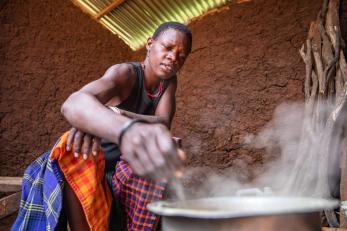
Traditional cuisine in Uganda is difficult to summarize, says Maurice Lamony, a communications assistant in Uganda. There are 54 recognized ethnic groups, each with their own unique customs and traditions around food.
But the COVID‑19 pandemic has had a huge impact on them all, he explains, as restrictions have prevented the planting of new crops and driven up demand and prices for available stores, especially beans and maize.
“On a positive note, the good old tradition of family meals has returned,” he adds. With closures and a curfew in place, parents are home and children are back from school. “Most families are eating all meals together again, especially dinner, as curfew has ensured that men [who would otherwise be out working] are home by 7 p.m.”
In Maurice’s family, the men have even been cooking more. “I personally would prepare breakfast and my two brothers took up the preparation of the other meals,” Maurice says. “It was not an official arrangement, we just found ourselves doing it most of the time.”
And a traditional dish for members of northern Uganda’s Acholi tribe, such as Maurice, is malakwang. The green leaf is a fast-growing vegetable that is easy to grow, making it ideal for families to produce in their home gardens.
The leaves are usually made into a tangy condiment and paired with sweet potatoes, a popular staple food, or sometimes meat. “The Acholi people particularly love it with wild game meat!” Maurice says.
For those wanting to try malakwang sauce at home, Maurice consulted his grandmother to put together this traditional recipe:
Ingredients
- 4 bundles malakwang (a bundle is usually 15-20 stems)
- 1 tablespoon salt
- 2 cups odii (peanut-sesame paste)
- ¼ teaspoon baking soda (optional)
Steps
- Remove the malakwang leaves from the stems, taking care to completely remove the stems. Wash leaves thoroughly.
- Sun dry the leaves for about 30 minutes (optional).
- Chop dry leaves in half. Meanwhile, bring a pot of water to boil.
- Place leaves in boiling water. Boil for 10-15 minutes, until tender.
- Check malakwang sauce for taste. If too sour, add baking soda and boil for several more minutes. Remove from heat.
- Check sauce again for taste. If too sour, drain all liquid and replace with clean water.
- Add odii and stir vigorously into a moderately thick paste.
- Add salt and stir thoroughly.
- Put malakwang sauce back on heat and warm to serving temperature. Serve with cooked sweet potatoes or choice of meat.
Download printable recipe cards for this dish and more ▸
Timor-Leste: Marotok
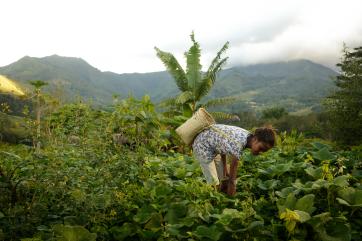
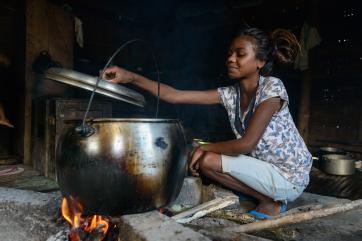
Traditional food in Timor-Leste also varies distinctly by region, because it’s made up primarily of what’s found locally — like corn, red and black beans, fish, pumpkin and different types of leaves. And even this has become less predictable during the pandemic, as food shortages have forced many people to eat less or differently than they normally would.
Still, one meal you will usually find in all parts of the country is marotok, says Graziela Xavier, a local learning coordinator. And despite the changes caused by the pandemic, food culture and customs remain the same.
“People in Timor-Leste mostly cook the traditional way, with firewood,” she says. “Only people that live in the city or have access to electricity use a different way to cook.”
That means marotok is cooked over an open fire. It’s a stew-like dish of corn, red and black beans, pumpkin, pumpkin leaves and flowers, and moringa leaves. The ingredients are boiled together until soft and thick, then salted to taste and served.
“Food plays a very important role because for specific occasions, or during ceremonies, you can recognize people and their role in the family or community by seeing the food provided to them,” Graziela says.
And now, as more people are at home during these uncertain times, food is a way to cope. Graziel says some have been using the time to try new foods and unique recipes. In her family, cooking has become a form of enjoyment and a way to spend time together.
To complete our collection of world recipes for you to cook up at home, here is Graziela’s recipe for Timor-Leste’s traditional maratok:
Ingredients
- 1 cup corn kernels
- 1 cup cooked red beans
- 1 cup cooked black beans
- 1 cup peanuts
- ½ small-medium pumpkin, peeled and cubed
- 1 tablespoon cooking oil
- Salt to taste
- 1 cup coconut milk (optional)
- Abundant pumpkin leaf and flower (may be substituted with moringa leaf or spinach)
Steps
- Combine corn, red beans, black beans and peanuts and mix well.
- Bring 1 liter of water to boil in a large pot. Add corn, bean and peanut mixture. Boil until soft and thick, adding additional water as necessary.
- Add pumpkin and mix well. Cook until soft, adding additional water as necessary.
- Add cooking oil, salt, and coconut milk as desired, for taste.
- When mixture is thoroughly combined and looks soft and thick, add pumpkin leaf and flower. Return to boil and cook until soft.
- Serve warm.